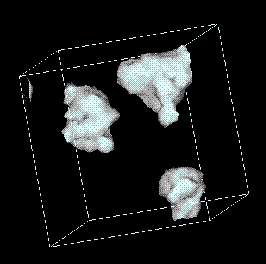Random Field Ising Model
Two varieties of disorder are encountered in spin models,
randomness in the strength of the bonds and randomness in
the strength of an externally applied magnetic field.
Research on
Spin Glass models,
which suffer from the first type of disorder,
has been very sucessful.
Random Field models, in which the disorder couples directly to the
order parameter have proven less amenable to progress.
Early work on the pertubative approach led to the prediction of
dimensional reduction and culminated in the beautiful
explanation of this phenomenon in terms of the supersymmetry
mechanism of Parisi and Sourlas. It became clear however that
this perturbative approach did not capture the complex behavior
of real materials.
We are still in need of
new non-perturbative understanding of the physics of random field systems.
In the Complex Systems group we are working on various aspects of this
problem including both simulation and analytical approaches.
We have concentrated our attention on the simplest model, that
of the Random Field Ising Model (RFIM).
Simulations
Since Monte Carlo simulations of the RFIM are hampered by extremely
long relaxation times (and there is no multi-spin cluster code
to speed things up)
we have been
motivatated to think of other approaches to simulating the system.
We have pioneered a direct approach to the mean field
theory.
The mean field theory (MFT) for the RFIM
is not as easily understood as for the pure Ising Model
because the mean field equations
are complicated and in fact, below a certain temperature, have many
solutions.
In this case we define MFT by the intuitive method of weighting each
solution with its Boltzmann factor (actualy e-Free Energy).
This comes into practical use only through our ability to solve
the mean field equations numerically.
We have used a very efficient code on
APE in order to deal with reasonably
large lattice sizes.
Although the correlation length is finite
for each solution of the mean field
equations
Guagnelli, Marinari and Parisi
we have shown that critical behavior can arise from the sum over
solutions and
have measured the resulting exponents.
Besides looking at the exponents, this method provides
intuition concerning the domain structure of the theory.

For example this shows the domain-like structure that exists at temperatures
above, but close to critical. For more details look at our
paper .
Theory
The theory of broken replica symmetry has been very sucessful
in understanding the physics of spin glasses and it is
natural to investigate its consequences for random field systems.
Within the context of the replica approach to the RFIM, the scenario
is as follows.
The replica symmetric solution becomes unstable as one reduces the
temperature below TRSB, at which point the
correlation length remains finite Mezard and Monasson.
The critical temperature TC at
which ferromagnetic order arises is at a lower temperature
TC < TRSB.
Finally one expects replica symmetry to be restored at an even lower
temperature.
Our understanding however, is limited because the form of replica
symmetry breaking is unknown. An approach based on a variational
method has had some sucess a the level of the effective theory of the
interfaces Mezard and Parisi but this technique has not
so far yielded results for the bulk problem Mezard and Young.
An alternative approach is to consider the effect of
instantons breaking the replica symmetry Dotsenko and Parisi
and this may be rephrased in the language of supersymmetry.
David Lancaster (djl@liocorno.roma1.infn.it) 16/1/95

